Sitting innocently enough in a booth for Tile-competitor Chipolo sits a 4iiii dual-sided power meter. To say it’s out of place in this booth at CES would be an understatement. But, it’d also be missing the point of a fascinating effort that 4iiii has undertaken: Adding theft tracking to their power meters. And it would ignore the almost more interesting work they’re doing just adjacent to that (which will have nothing to do with power meters).
First though, we need to back-up a bit. Most folks are probably familiar with Tile, TrackR, Chipolo. These companies usually sell small tracker pods that clip onto your keys or other items, enabling you to find them when you lose them. However, it’s bigger than that. With millions of consumers using these apps, they form a bit of a mesh network – allowing folks to find objects almost anywhere in the world. As long as your object passes by another person with the app loaded, it’ll show the location. The underlying technology uses Bluetooth, and most of these trackers have a range of about 60-100 feet (20-30 meters).
Of course – none of what I described in the previous paragraph is new or debatable. It’s been going on for years and is well proven to be pretty effective, assuming the thing you’ve lost is using a platform/service popular in your region. So, for example, Chipolo is more popular in Europe with 1.6 million units, while Tile and TrackR are more popular in North America. Tile has sold over 10 million Tiles, and TrackR some 5+ million units. This map of New York City shows a point in time snapshot of where Tile users are:
So what’s this got to do with 4iiii? Well, they’ve unveiled a bit of a concept for implementing this into their power meters. This would enable you to mark your power meter as ‘lost’, and then the next time it passes by anyone using the app on the tracking network, it’ll register a ping and show the exact location of your power meter on the map.
To the outside, the unit looks no different:
Internally, the company is leveraging the Nordic nRF52 chipset that’s common in the vast majority of sports technology (and beyond) devices out there. It’s simply beaconing over Bluetooth Smart, with you having pre-registered your power meter in the app with the name of your choice. The name only matters to you, in the event you want to add it to your existing Chipolo/etc account:
In fact, both sides (if using a dual-leg variant) are actually registered in the networks, which is even more interesting because the right side takes tools to open up the battery compartment. Not that it really matters, eventually someone will put in batteries in that power meter, and you’ll at least get that to ping somewhere.
They demonstrated this at CES using a beta version of their regular 4iiii power meter app (the same one you’d use to tweak settings or update firmware). It’s now got a new tab that allows you to mark your power meter as lost (we had renamed this one as ‘Mike’):
Now, the power meter is *always* beaconing (even if sitting in a garage), but doing so in a super low-power way, just like the various trackers that Chipolo or Tile sell. Meaning, it has virtually negligible power impact. Tile, for example, is designed to beacon for up to a year on a single coin cell battery, Chipolo even has LTE-enabled ones.
Once you’ve marked your unit as lost, you merely wait for someone with the app running in the background on their phone to see the beacon. That person doesn’t do anything, this all happens in the background automatically. You’ll then see the location on the map:
All of this within the 4iiii app. No need to go to some other app/platform/company to do this.
At this point, if your bike was indeed stolen, you’d likely contact authorities (or your favorite repo man), and get your bike back. Since most bike thieves would be unlikely to realize your bike is transmitting out from a coin-cell battery sized compartment on the crank arm – there’s actually a pretty good chance that you’d get location pings.
Here’s the full demo of it in real-time:

Note that this particular demo was done on Chipolo’s network, though there’s nothing stopping 4iiii from looking at other beacon/tracker networks. The company certainly seems to recognize this, and noted that the development work to do so isn’t huge. Given Tile is far larger in the US than Chipolo, and the opposite true in Europe, it would make sense to support multiple networks concurrently (which the company says they could certainly do). It sounds like we’ll have to wait till down the road to see how it manifests itself.
It’s Not Obvious:
Here’s the little secret though: This isn’t about 4iiii power meters.
Nope, it’s about Obvious.
WTF is ‘Obvious’ you ask?
That’s the subsidiary company that 4iiii has developed to market this and other technology to other companies. See, Obvious (yes, that’s actually the name of the company, 4iiii has a special way with company names), is their software and services arm. And it’s got its sights set on more than just locating stolen power meters.
Obvious actually has two ‘products’ right now (though technically speaking A would be part of B in some cases):
A) A packaged offering that would allow a company to add the theft/lost-tracking functionalities onto any device
B) An app store for embedded devices, allowing companies to offer payment for functionality within wearable or any other device
Said more simply, the first one simply takes what you saw in the previous section and markets it to anyone out there as a service/platform. So if Ikea wanted to add it to lamps they could. Doesn’t matter the device, as long as it has compatibility chipsets in it (which, most would). The second though is more interesting. It’s partnered with Nordic Semiconductor to give companies a way to update the firmware on a given device in a secure/authenticated way, tied to a backend payment platform.
I get it, for non-geeks, this is probably as confusing as Bunny Pancake. Let me give you this fictional example:
1) You’ve got a GPS watch, but it doesn’t have the ability to show you sleep tracking
2) However, your GPS watch allows you to ‘unlock’ that feature for $4.99
3) You say great, let’s do this.
4) You go to that GPS company’s website/app, and pay your $4.99
5) Your device gets a new firmware update that enables that feature after authenticating you
6) You now track your sleep
In the above scenario, Obvious is actually responsible for items 4-5.
They’ve got app plug-ins for iOS and Android that allow companies to quickly plug it into their own apps. Obvious handles all the payments and processing and messy financial overhead that companies hate. Then, they manage the firmware updating process too. They validate that the specific unit at hand is authorized for the new feature-laden firmware, and then apply the firmware. All of which means that you as a consumer just ‘upgraded’ your device with the same simplicity as you buy apps on an app store.
Obvious can handle both complete firmware replacements, as well as partial firmware updates. They can also do simple feature unlocks sans-firmware updates. Their thinking is to let companies get out of dealing with OTA (Over the Air) updates, as many companies struggle with this (something I’ve seen numerous times in testing devices). Doing firmware updates properly is hard, so it’s logical to want to avoid dealing with it.
If this all sounds a bit geeky to you – that’s fine. It has no impact on your 4iiii power meter, or your experience using it. Instead, it’s about 4iiii adding another business line that could help other sport tech companies down the road. And it sounds like they’ve already got some lined up.
I’ve long argued that paid feature unlocks would make a ton of sense in the fitness device realm (if implemented correctly). There’s plenty of other industries that do this today, so it’s hardly new. It would allow companies to standardize on (for example) a single hardware platform or set of hardware devices, and then allow the consumer to pay for the features they actually want. Effectively separating hardware from features.
The downside, of course, is if a company poorly implements these devices, and ends up nickel and diming their customers. Realistically though that’ll be a short-lived problem, since the sports tech landscape is hyper-competitive with tons of choice. Consumers will simply go elsewhere, no matter how big the player.
Going forward:
So at this point, you’re likely asking: What’s it going to cost?
And 4iiii sees this as a concept that they’re looking to bring to fruition later this spring at Sea Otter (April) on their power meters. Perhaps it’s totally free, or perhaps it’s something that has a one-time fee, or perhaps there’s a subscription service element to it. And it’s not super clear which units would be enabled either.
Either way, I think the concept is fascinating. No, this won’t stop a thief from stealing your bike (likely out of your home or perhaps while you have a coffee at a café post-ride). But it will give you one more tool in your arsenal for getting back your bike. And I could see if you were looking at similar power meters options (for example, comparing a 4iiii unit to a Stages), this could push you over the edge towards 4iiii, especially if it was no/low cost.
Of course – the bigger play here for 4iiii (err…Obvious), is enabling this in other devices. And likely not even fitness devices, though, that has appeal as well. It’s going beyond fitness to anything that’s got value that you don’t want lost. Not to mention the entire app-store bit, which would significantly change the sports tech industry (and industries beyond it).
While it’d be easy to assume a small Canadian fitness company wouldn’t be the expected player to bring this technology to others, that’d also make the mistake of forgetting that the founder of said company is the one who developed (and then sold) ANT+ at a time when there was no other super-low power wireless tech, which now sits on tens of millions of devices. So, they do have some experience in this whole technology game.
With that – thanks for reading!
FOUND THIS POST USEFUL? SUPPORT THE SITE!
Hopefully, you found this post useful. The website is really a labor of love, so please consider becoming a DC RAINMAKER Supporter. This gets you an ad-free experience, and access to our (mostly) bi-monthly behind-the-scenes video series of “Shed Talkin’”.
Support DCRainMaker - Shop on Amazon
Otherwise, perhaps consider using the below link if shopping on Amazon. As an Amazon Associate, I earn from qualifying purchases. It doesn’t cost you anything extra, but your purchases help support this website a lot. It could simply be buying toilet paper, or this pizza oven we use and love.

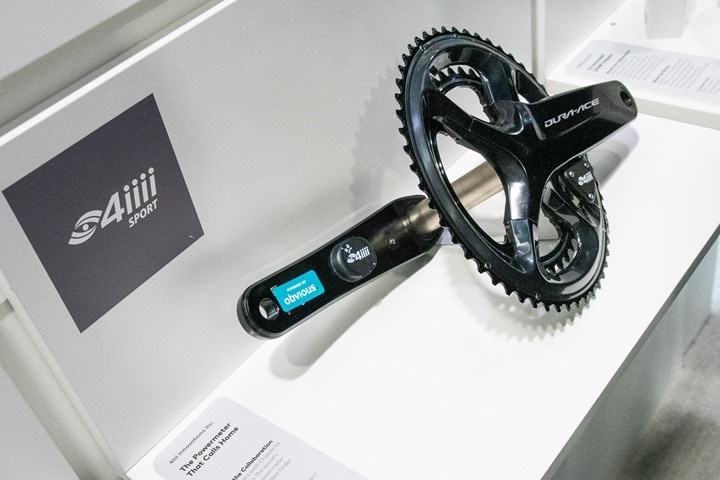

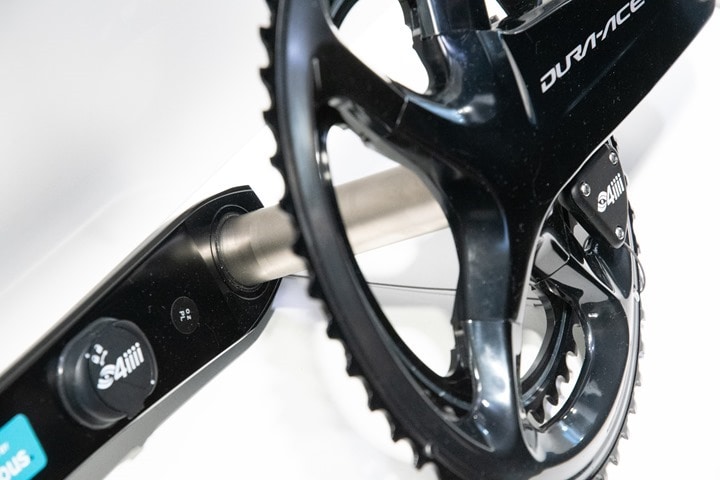
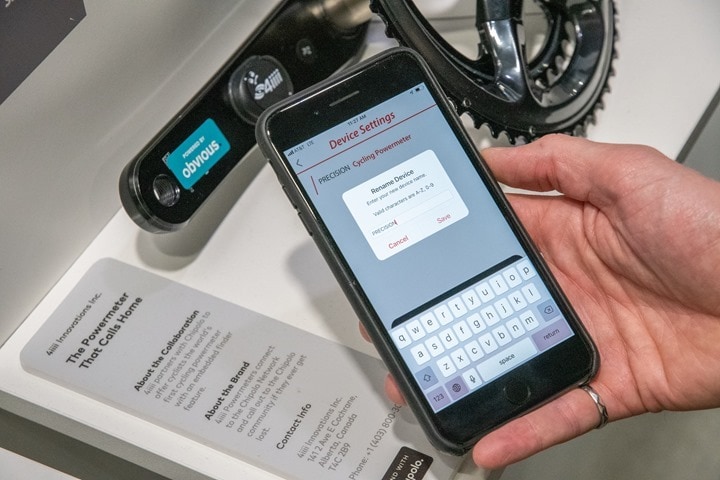
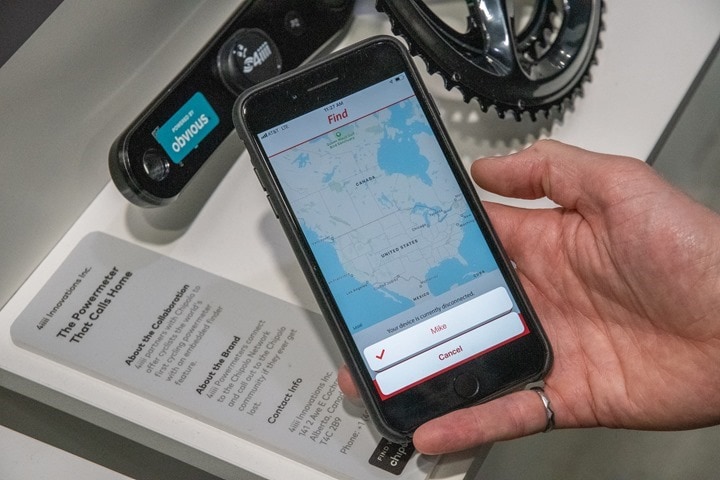
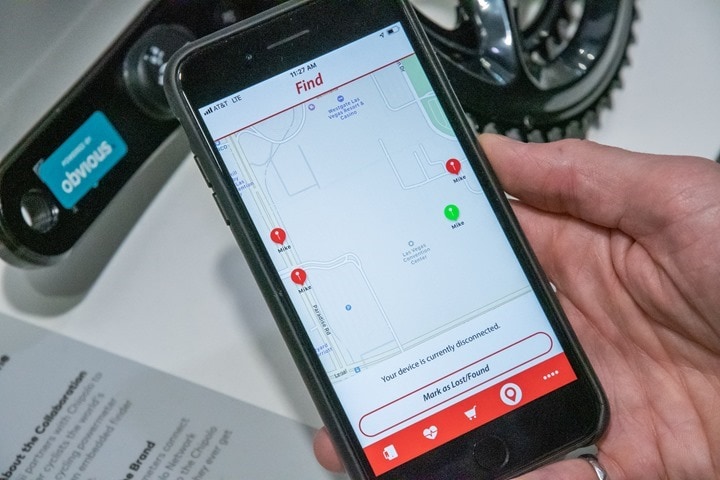
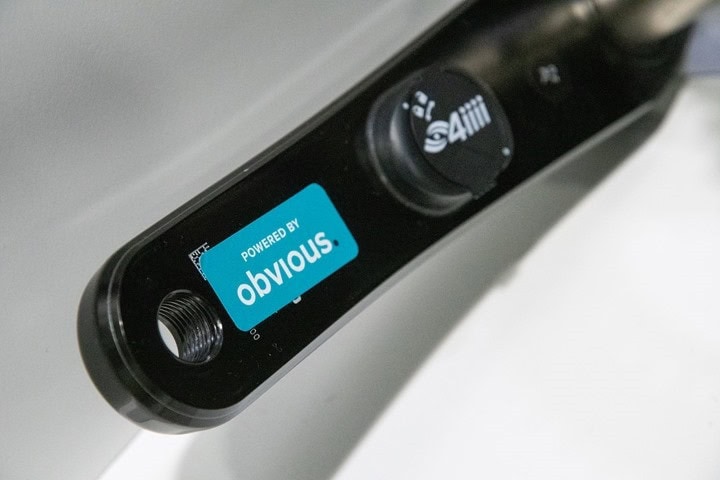

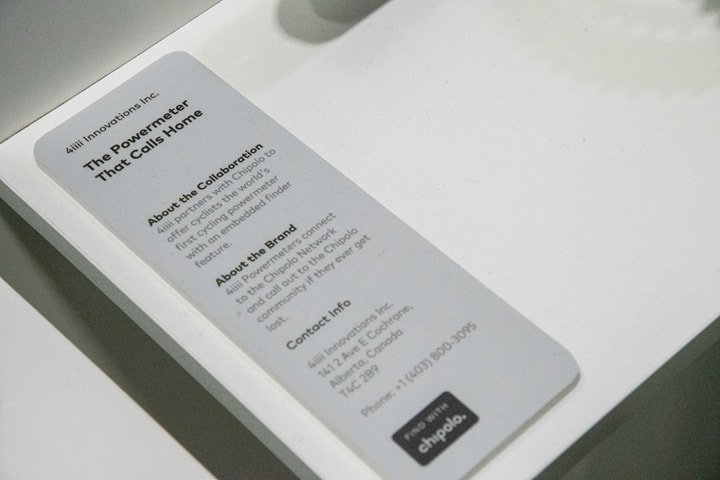





















Nice… it is like a gift (to myself) that keeps on giving… although at a small cost. Good thing though is that unlike Tile, battery on the 4iiii is either replaceable or rechargeable.
@Eric Tile’s latest does offer replaceable batteries (finally!)
Curious why is this a tech tied to power meters? Why wouldn’t this just work to put a device like this in the frame?
Pretty much by definition, a power meter has a power source, and for it to be used, a thief/fence/purchaser of dodgy goods has to keep it recharged/fresh batteries.
A frame-inserted device may not be kept charged. Although this linked to a di2 battery could make sense.
Correct, a frame inserted device would need some sort of power source. That could be something like a small solar cell though, to be fair.
In the case of the 4iiii unit, with the coin cell, the battery would likely last a ton of months before it died.
No it wouldn’t, only if you use an active beacon system. I was considering a solution similar to this recently using passive components just like the tags you use when racing. Epoxy one into the frame and then place a sensor loop at various points such as ferry terminals and shipping locations, even airports. You then get a ping when a protected device passes through which indicates stolen property, even if it’s inside a shipping container. A simple API driven website would allow reporting of those stolen items to make them flag up when travelling. The cost of said website would be pennies per year using something like Logic Apps so easy to maintain based on an initial purchase price of the tag of say $10. Police could easily use this technique as a sting operation to proactively find bike thieves too.
The problem here would be that all such devices can be trivially disabled with microwaves (as can the 4iiii) rendering them ineffective. Thieves are not stupid for the most part and bike crime has long since been industrialised with people driving around in vans taking many bikes per day. They would quickly catch on and start disabling any and all electronics as soon as they take a bike. The loss of profit would be negligable if the PM is broken in the process. All proceeds are profit in theft since there are no outgoings!
1. Chipolo relies on 3rd party detection, no? Not sure how many of those would be around where many stolen bikes end up.
2. I Tracked a bike thief with a mate who had >10k of bikes stolen. Even found the address. Police not interested. Mate had senior contacts in police and eventually got a warrant. Police refused to execute it as the criminal’s house where the bikes were might be dangerous.
sad but true.
There has to be a will to enforce law. Maybe other countries are better at this.
The solution you propose requires dedicated sensor loops – which don’t exist and would have to be deployed, so you get a chicken-egg issue where the tags are useless until there are detectors, and the detectors are useless until there are tags. The Tile, TrackR and Chipolo systems work because they depend on a detector network (a bunch of cell phones) that is already deployed.
As for the “thieves are not stupid for the most part”, this is 80/20; maybe 80% of the thefts are from the 20% smart thieves, but deterring the 80% dumb ones is still a valid goal.
@tfk I had my bike stolen in San Francisco in 2016, from a private garage where it was properly u-locked. To say the police didn’t care is an understatement. All they do here is have you fill out a form on a website so you have that to submit to insurance.
I think the lack of will to enforce this crime is common, and part of why the crime is so common.
@Robert most bike crime these days is fully organised and bikes are generally exported in bulk for resale after the theft. The loops wouldn’t need to be deployed in many places and are very cheap. You’d only realistically need to target ports and air freight and there are not many of those. The beauty of the solution would be that detection would be at the entry point on the road so no effort involved. Police could also use such a solution in town centres to spot a van leaving with stolen bikes inside.
All this assumes the police care enough to try of course. And generally they don’t.
Now you just have to connect the beacon finding platform to Strava, Garmin Connect and so on to maybe find out who was at this time at this place with his bike.
Paying to unlock/upgrade, if handled like DLC in the video game market, will be a huge cash cow to the industry and a grab for customers. How much faster will new devices roll out “incomplete ” only to have firmware patches on Day 1. No thanks.
It depends on how it goes, and of course, company to company.
I think the appeal for something like this would be to bring down the cost of higher end watches with nicer materials where the person didn’t care a ton about all the features. Also, it could prolong life into older watches and allow folks to upgrade.
Of course, it could also go poorly.
If I could’ve done an ala cartel upgrade to my FR645 to add power meter support I’d have never bought an F5+.
Before you ask why I didn’t just buy what I needed at the time I bought the 645, I’m primarily a runner who cross-trains on the bike but didn’t use power until I bought a smart trainer then found I wanted power stats all the time.
This is what Stryd did with the short lived Stryd lite. $100 for a their highly accurate foot pod and if you decide you want to add running power to it you pay another $100. My impression was that it worked pretty well and provided a lower cost of entry for hesitant consumers. Don’t know if they killed it because it was a limited run thing they did with Zwift or because the hardware cost didn’t work as well as they expected but it seems like a prime example of a good way to implement this sort of tech. AFAIK Stryd did it all in house.
Or maybe it will be like Cannondale included a power2max on their SyatemSix last summer, only for the user to have to fork out extra $ to “unlock” and be able to use it.
Tech geek checking in here— yes, this is super cool to find a stolen bike and would make me think twice about which company gets my business for my next crank, but the implications of the service based technology are utterly fascinating.
Considering how many times I have heard of Garmin Vectors being stolen at Ironman events, or bike computers…this would be great for a lot of athletes, triathlete or not.
I think this is rally good news. Hopefully in the future it could also be powered with your di2 battery.
Better use of the tech would be for gps devices. Connect your Garmin by Bluetooth and if/when you lose that connection the tracker app knows roughly where. So many forum posts locally about lost edge units. Use the tether of course but also let’s leverage technology a bit more. If you could get a rough location on the trail or road, it would infinitely improve your chance of finding the device.
Yup, if Garmin (or whomever) were to leverage this tech (basically just a software update in many cases), then if/when another person passed by it with a tracker app open, it’d register the location to the original owner.
But then a Garmin device is useless without the platform so it would be considerably more efficient to have a kill command and theft reporting in Connect just like Apple have for the iPhone. Phone theft has dropped considerably since this was introduced.
Obvious should sell their service to the cable tv providers.
Why has it taken them so long. And they still don’t get it.
It’s like the record companies – 1000 lps (dvds) or 10,000 singles.
They could also embed a gps tracker that will turn on the first time it encounters a nearby app after being registered as “stolen” and from then on, it will load its gps track data to the next app it encounters and so on. This would make tracking easier.
Could Obvious partner with Garmin to handle the payment piece of the ConnectIQ app store, or am I barking up the wrong tree?
Certainly could, though given CIQ wouldn’t directly impact firmware or feature enablement, it’d be a bit askew of what Obvious would typically focus on.
This is utterly brilliant, and I’m kicking myself for not having thought of this earlier. I have Lapas (link to findlapa.com) which I guess are like Chipolos in that they’re BLE trackers you affix to things. I’ve been thinking of iOT devices and how I’m surprised wifi specs don’t allow for a secure, low-bandwidth communication channel for iOT devices to send/receive not much more than a ping. This would revolutionize iOT communication and not require cellular chips for much of this sort of “I’m here now” communication.
The moment I saw the title of this article it all came together in my head, and I’m super stoked for 4iiii that they’re implementing this. Publish the API spec and open it to third party hardware developers == brilliant. Next step they’re probably doing is opening up the software side too so apps like Garmin Connect can implement “find by Obvious” or whatever they’ll call it. A tracker like this should be in everything, with access and data controlled by the device’s owner, of course.
One thought about this “pay to unlock firmware” deal. There are nuances to it, but I’m generally firmly opposed to how it’s often implemented. For example, if Tesla’s selling me a 100kwh battery, I do NOT want to have to pay extra to “unlock” my battery. The hardware is already there. On the other hand if there’s future functionality developed for hardware I’ve already purchased, I’d possibly be willing to pay for that.
I’m assuming this is only for new 4iiii power meters going forward? Not for current ones? And will it work with left side only ones?
Hi ekutter!
The tracking capabilities will be available on new and existing 4iiii powermeters once we release it so there is no need to get a new 4iiii powermeter to take advantage of this technology. It will also work with both sides of a dual system so you will be able to track either powermeter,
Scott Cooper
Product Manager, 4iiii Innovations
Awesome. Thank you.
The big issue with this new technology is the law enforcing agencies. In my country (Sweden) it is common to have gps trackers on outboard engines. They get stolen a lot. What good is it for the owner to know that the engine , stolen in Sweden, is in Romainia being used by a fisherman every day? (Real example.) The law enforcing agencies will not do anything about it.
Even if you report it to the police right away an tell them where the stolen object is they will in most cases do nothing. They have other priorities.
Ok, so you go to the stolen object and get it back by your own means? This is illegal and you may be prosecuted for this!
Conclusion: Any kind of tracker is a waste if money in most cases.
I think it’ll honestly depend on the locale. From all the cases I’ve seen in the US, if police have a live tracking beacon/tracked for high value stolen goods, they seem to revel at the opportunity for a take-down. Likely because there’s often more stolen goods there and thus the chance for a legit arrest.
Whereas if it’s more nebulous, less so. Obviously, once you cross borders that’s a whole different ball game. It with tech like this, the speed to tracking (assuming not disabled), is a actually really quick.
Does this work with “old” 4iiii powermeters, or is a feature only avalaible in the new lots of 4iii powermeters?
It certainly will work on your current 4iiii powermeters so nod need to buy a new one!
Scott Cooper
Product Manager, 4iiii Innovations
Tile if just in beacon mode would probably last longer then a year. Tiles also receive a signal to sound a tone which allows the tile to be found. Sounds like this is broadcast only
Why don’t bike manufactures get together and standardize a RFID tag to put into all higher end frames? There are passive tags with a range up to 26′ (8m) Should be pretty cheap to do and if all bikes have it then it would be something that could be depended on to always be there
I’m with a couple of other posters above wondering about currently deployed meters. The email I just got from 4iiii says “4iiii powermeters already in use will be able to take advantage of this new feature.“
I have a left-side only 4iiii meter on one of my bikes that is a couple of years old. Would love to know if it applies here, as it’s my commuter bike and perhaps a little more likely to be stolen.
Hey Craig! It certainly will work on your existing powermeter once it is released!
Scott Cooper
Product Manager, 4iiii Innovations
Would they need to set up their own app mesh network or piggyback onto an existing app/network?
My big worry is that Obvious opens up the door to a subscription-based model, which is a bandwagon so many companies seem to be jumping on these days – a life-long steady income stream from every device you sell without the middleman costs. In theory you could argue that only paying for functionality you use, when you use it, should be advantageous to the consumer, but in every example I’ve seen, “the house always wins”.
Subscription seems reasonable (to me) for pure services like Strava or Zwift. But imagine buying your new Garmin fenix 6, overjoyed that it was cheaper than the 5+, but then setting it up for your first cycling activity and:
Subscribe to CYCLE activity @ £1.99/month? (See our Triathlete bonus package @ £4.99/m)
Use ANT+ @£0.99/sensor/month? (Include Bluetooth for just £1.49/sensor/month)
Enable optical HRM @£0.99/month?
Enable FirstBeat Analytics @ £2.99/month?
Enable music @ £3.99/month?
etc
etc
Please, no.
True, though, I don’t see that type of de-bundling happening anytime soon.
Instead, I see it far more likely that companies will start to experiment with ‘evergreen’ type subscriptions. For example, you pay $X/month to always have the latest model Garmin, Wahoo, whatever – within a given price class/category.
With the price of the top Garmin being comparable to a phone, you’d think they’d chuck a sim in it and partner with the telecoms companies to provide it on a plan, probably with a high end phone
Yeah, as we saw with the new Vivoactive 3 Music LTE, the whole SIM thing is pretty challenging.
Will this feature work on the Specialized branded 4iiii power meters?
Firmware update yesterday…this feature is live now.
But only -apparently- if you have a IOS phone and the IOS app. No Android support?
Hi Barry,
Yes, you are correct, it is currently only supported for iOS. We are working hard on getting out an Android version as soon as we can. Sorry for the inconvenience if you’re an Android user!
Scott Cooper
Product Manager, 4iiii Innovations
Any progress on getting an Android app update out?
ANDROID? Waiting……..
And waiting…..?
A complete ZERO from 4iiii on Android implementation!
A very welcome collaboration by 4iii with Chipolo
With bike jackings on the rise (depending on the country you live in). I was wondering if Ray ever looked/or considered looking into theft tracking devices that have GPS and cellular connectivity? There are options available from the likes of spybike, Pbike from Planetus, DanTracker, sherlock, pinggps, itrakit but user feedback/reviews are fairly sparce (some are Indiegogo projects). Costs and effectiveness have been a barrier to widerspread use. But nonetheless it would be interesting to hear of experiences from the wider dcrainkmaker community with these devices.
Jon